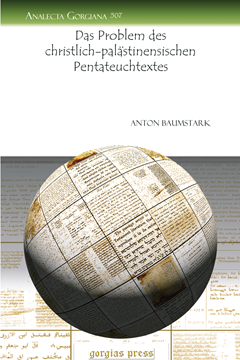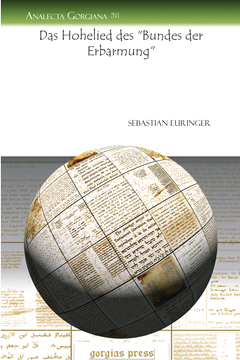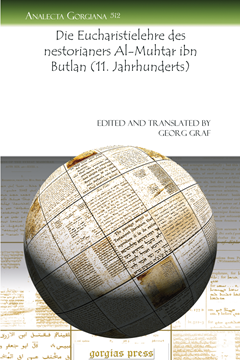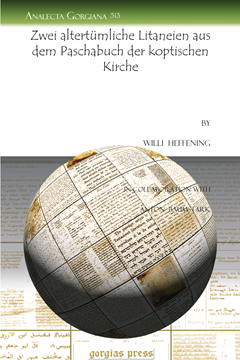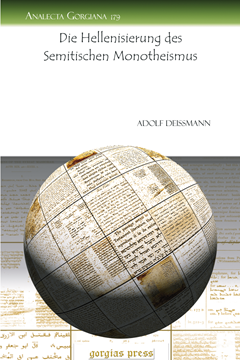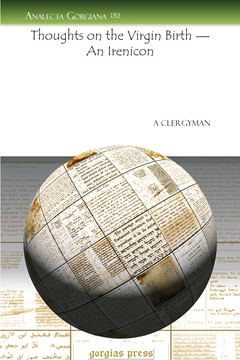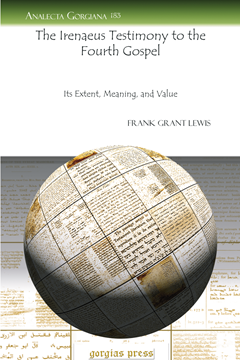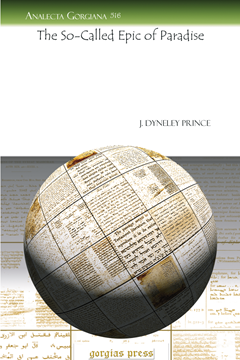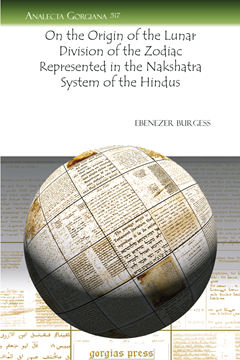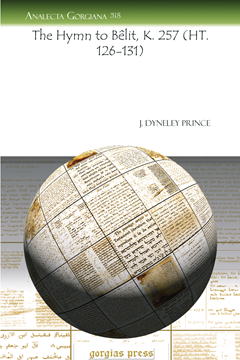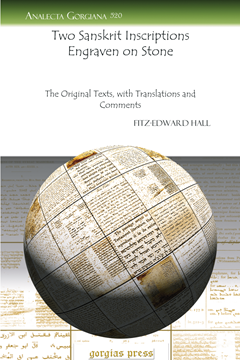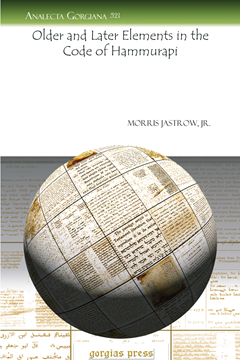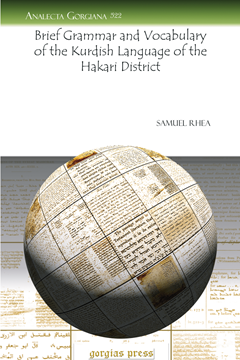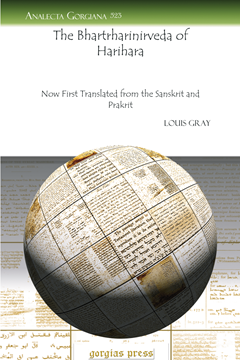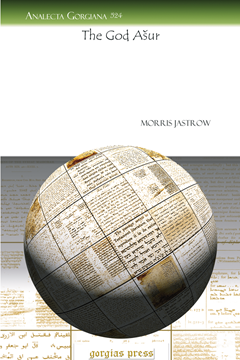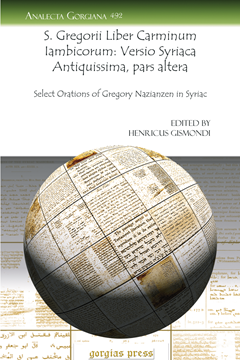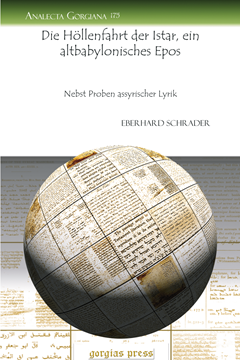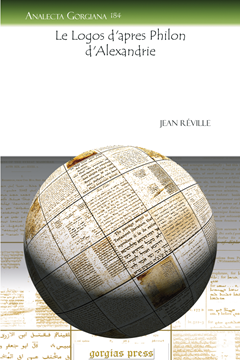Analecta Gorgiana
Analecta Gorgiana is a collection of long essays and short monographs which are consistently cited by modern scholars but previously difficult to find because of their original appearance in obscure publications. Carefully selected by a team of scholars based on their relevance to modern scholarship, these essays can now be fully utilized by scholars and proudly owned by libraries.
Das Problem des christlich-palästinensischen Pentateuchtextes
Series: Analecta Gorgiana 507
ISBN: 978-1-60724-986-3
Anton Baumstark discusses the various, complex problems inherent in any attempt to determine the influences from other translation traditions on the form of the Christian-Palestinian text of the Pentateuch.
$36.00 (USD) $21.60 (USD)
Ein "Evangelium"-Zitat der manichäischen Kephalaia
Series: Analecta Gorgiana 508
ISBN: 978-1-60724-987-0
Anton Baumstark compares the text of a Gospel citation found in a Coptic Manichaean Kephalaia with other versions of the text in order to demonstrate that it was influenced by the Diatessaron tradition.
$36.00 (USD) $21.60 (USD)
Ein Bilderzyklus in der Gräberhöhle der St. Euthymios-Laura auf Mardes (Chribet el-Mard) in der Wüst
Zugleich ein Beitrag zur Geschichte des frühbyzantinischen Mönchtums und zur Topographie der ältesten Lauren und Koinobien Palästinas
Series: Analecta Gorgiana 509
ISBN: 978-1-60724-988-7
The caves that make up the coenobitic Monastery of St. Euthymios include several interesting and well-preserved wall paintings. In the present article, Andreas Mader presents a thorough description of these caves and paintings and includes several photographs for reference.
$43.00 (USD) $25.80 (USD)
Erbe christlicher Antike im Bildschmuck eines arabischen Evangelienbuches des 14. Jarhunderts
Series: Analecta Gorgiana 510
ISBN: 978-1-60724-989-4
In the present article, Anton Baumstark describes the decorative illustrations found in an Arabic gospel text of the fourteenth century and concludes that they represent antique artistic features that were preserved only in the Oriental manuscript tradition.
$39.00 (USD) $23.40 (USD)
Das Hohelied des "Bundes der Erbarmung"
Series: Analecta Gorgiana 511
ISBN: 978-1-60724-990-0
In the present article, Sebastian Euringer presents a German translation of three Ethiopic poetic texts, which he supplements with a bibliography, an introduction, and extensive critical notes including commentary.
$45.00 (USD) $27.00 (USD)
Die Eucharistielehre des nestorianers Al-Muhtar ibn Butlan (11. Jahrhunderts)
Edited and Translated by Georg Graf
Series: Analecta Gorgiana 512
ISBN: 978-1-60724-991-7
Georg Graf publishes here an edited Arabic text and German translation of a “Treatise on the Eucharist” attributed to Abu l-Hasan al-Muhtar ibn Butlan. Graf supplements the text with an introduction and brief notes.
$41.00 (USD) $24.60 (USD)
Zwei altertümliche Litaneien aus dem Paschabuch der koptischen Kirche
By Willi Heffening; In Collaboration With Anton Baumstark
Series: Analecta Gorgiana 513
ISBN: 978-1-60724-992-4
Willi Heffening publishes a German translation of two litanies that are preserved only in a Paschal book from the Coptic Church. Heffening also includes an introduction and supplements the translation with critical notes.
$37.00 (USD) $22.20 (USD)
The Sahidic Translation of the Book of Job
Series: Analecta Gorgiana 178
ISBN: 978-1-60724-271-0
Generally considered the leading pre-Islamic dialect of Coptic, Sahidic is an important language for Orientalists. Perhaps because of its body of original, non-translated material, Sahidic is the Coptic dialect most commonly studied outside of ecclesiastical settings. Sahidic, however, is also used as a language of translation, as in this booklet containing the biblical book of Job in that dialect. Unparalleled as a source for beginners in Coptic, this small portion of the Bible presents a familiar starting point. Coptic scholars will also find this resource worth their time as an historical example of the language and its study. Known also as Thebaic, this form of Coptic was used for translating major portions of the Bible. Since it was used by the church as well, this tract will be of interest to biblical scholars as well.
$47.00 (USD) $28.20 (USD)
Die Hellenisierung des Semitischen Monotheismus
Series: Analecta Gorgiana 179
ISBN: 978-1-60724-272-7
Deissmann was a scholar well known for his work with the Greek of the New Testament. In this little volume he considers the Hellenization of Semitic monotheism. Primarily concerned with the changes after Alexander’s conquest, the book is a brief exploration of Greek religion in the aftermath of conquest. Semitic monotheism was, according to Deissmann, a new concept for the Greek world. Hellenistic outlooks had long been influenced by classical viewpoints. Into this cultural milieu the Judaic concept of monotheism made immediate inroads. This influence is explored primarily in linguistic form, including considerations of the Septuagint. Both Hellenists and Semitic scholars will find material of interest here. Observations made by Deissmann influenced later thought in this field. Stretching across disciplines, this study will interest cultural historians as well. Share the sense of discovery with this useful booklet.
$35.00 (USD) $21.00 (USD)
The Christian Approach to Moslems
A Course for Adult Groups
Series: Analecta Gorgiana 180
ISBN: 978-1-60724-273-4
In the days when many Americans were first becoming aware of the larger religious world, Sailer introduced them to Islam. Reaching for an understanding of how the two religions relate, he begins this study with an introduction to the Muslim world. Sailer approaches the subject with a respect for Islam and its believers. Aiming to prepare missionaries for Muslim regions, he writes for a general readership. Understanding, he believes, begins with an overview of Muslim life and the character and influences on Islam. Designed as a short adult course on the subject, this booklet has instructions for the leader of an adult group on the topic. Interested in the impact of Christianity on Islam, Sailer explores what churches might do. Taken all together, this little booklet spells out a plan of action for what the author saw as a missionary opportunity.
$42.00 (USD) $25.20 (USD)
Christianity and Islam
By C. H. Becker; Translated by H. J. Chaytor
Series: Analecta Gorgiana 181
ISBN: 978-1-60724-274-1
From one of the leading scholars of Islam in the last century comes this exploration of Christianity and Islam. Right from the beginning Becker notes that there are different points of view on the subject. Examining the nature of the subject and the historical connections between the religions, he turns to the meeting of the two faiths. Emerging outlooks at the time demonstrated just how much these religions affected each other. Those interested in the history of western religions will find this a refreshing resource. Also useful to students, this informative booklet is a welcome find.
$59.00 (USD) $35.40 (USD)
Thoughts on the Virgin Birth — An Irenicon
By A Clergyman
Series: Analecta Gorgiana 182
ISBN: 978-1-60724-275-8
Among the many issues that plague Christian sensibilities, perhaps none is as stressful as the virgin birth. Since the advent of higher criticism the concept itself the concept had grown increasing untenable to the point that an anonymous cleric decided to take action in this booklet. Scientific study of the Bible had revealed that what had appeared to have been predictions were often mistranslations, and many were shaken by such revelations. Succinct and irenic, this treatment will be appreciated by Christians who are still concerned over the implications that serious biblical study raises.
$39.00 (USD) $23.40 (USD)
The Irenaeus Testimony to the Fourth Gospel
Its Extent, Meaning, and Value
Series: Analecta Gorgiana 183
ISBN: 978-1-60724-277-2
One of the issues consistently plaguing New Testament scholars is the date of the Gospel of John. No consensus exists on this thorny dilemma. Looking at the world around the Bible, extrabiblical testimony often provides evidence for such questions. Insights drawn from Irenaeus are used by Lewis to help shed light on the topic. Noting the extent to which Irenaeus bears on the fourth Gospel, Lewis discusses the potential authors of John that could have been known by Irenaeus. Ending with modern conclusions to the issue, Lewis provides a useful summary of state of Irenaeus studies around the beginning of the twentieth century.
$45.00 (USD) $27.00 (USD)
The So-Called Epic of Paradise
Series: Analecta Gorgiana 516
ISBN: 978-1-61719-031-5
The article refutes many of the arguments Stephen Henry Langdon made in his article on the text “The Sumerian Epic of Paradise, Flood, and Fall of Man”. The essay concludes with the entire text laid out and a commentary.
$36.00 (USD) $21.60 (USD)
On the Origin of the Lunar Division of the Zodiac Represented in the Nakshatra System of the Hindus
Series: Analecta Gorgiana 517
ISBN: 978-1-61719-032-2
Burgess attempts to prove the originality of the nakshatra system to the Hindus. He proves the early existence of this system and disproves the origin of the lunar zodiac system to the Chinese and the Arabs.
$36.00 (USD) $21.60 (USD)
The Hymn to Bêlit, K. 257 (HT. 126-131)
Series: Analecta Gorgiana 518
ISBN: 978-1-61719-033-9
The Sumerian hymn K. 257 is in the Emne-sal dialect, which is the non-Semitic designation for a variation of Sumerian. The focus of the hymn is the goddess Belit. However, no conclusion was reached about her origin.
$36.00 (USD) $21.60 (USD)
Two Sanskrit Inscriptions Engraven on Stone
The Original Texts, with Translations and Comments
Series: Analecta Gorgiana 520
ISBN: 978-1-61719-035-3
A significant portion of this article contains the original texts, translations, and comments of two Sanskrit inscriptions discovered in 1857. Both inscriptions list the names of the rulers of Chedi and the names of their consorts and kinsmen.
$39.00 (USD) $23.40 (USD)
Older and Later Elements in the Code of Hammurapi
Series: Analecta Gorgiana 521
ISBN: 978-1-61719-036-0
Jastrow addresses how the final codification of the laws of Hammurapi evolved and which process the Babylonians used to get there. The Code of Hammurapi was subject to constant adjustments, providing that conditions constantly changed and new situations arose.
$38.00 (USD) $22.80 (USD)
Brief Grammar and Vocabulary of the Kurdish Language of the Hakari District
By Samuel Rhea
Series: Analecta Gorgiana 522
ISBN: 978-1-61719-037-7
Samuel A. Rhea created a brief vocabulary and grammar while doing missionary work with the Kurds. His goal in creating a Kurdish grammar was to translate the Old and New Testaments into Kurdish.
$39.00 (USD) $23.40 (USD)
The Bhartrharinirveda of Harihara
Now First Translated from the Sanskrit and Prakrit
By Louis Gray
Series: Analecta Gorgiana 523
ISBN: 978-1-61719-038-4
Bhartrharinirveda of Harihara is a play that glorifies the Yoga philosophy, which teaches that the summum bonuzz is the discrimination and separation of soul from matter, thus leading through renunciation of the world to isolation of the ego.
$38.00 (USD) $22.80 (USD)
The God Ašur
Series: Analecta Gorgiana 524
ISBN: 978-1-61719-039-1
The name Asur is difficult. In cuneiform, it is designated for the city, country, and deity. However, it appears that the deity was named after the city, which emerged first.
$37.00 (USD) $22.20 (USD)
Tiamat
Series: Analecta Gorgiana 525
ISBN: 978-1-61719-040-7
Tiamat was the Babylonian sea deity. The sea was affiliated with evil. Tiamat was therefore thought to be evil. As a result, the writers of Genesis 1 purposely omitted any wording relating to the word ‘sea’.
$37.00 (USD) $22.20 (USD)
Versio Syriaca Antiquissima, pars altera
Select Orations of Gregory Nazianzen in Syriac
Edited by Henricus Gismondi
Series: Analecta Gorgiana 492
ISBN: 978-1-60724-970-2
This volume contains Syriac texts of the old Syriac translation of Gregory Nazianzen’s orations edited from British Museum manuscripts. Fourteen orations, in whole or in part, are included, with concordance of the texts with Migne’s Patrologia Graeca edition.
$49.00 (USD) $29.40 (USD)
Die Höllenfahrt der Istar, ein altbabylonisches Epos
Nebst Proben assyrischer Lyrik
Series: Analecta Gorgiana 175
ISBN: 978-1-60724-246-8
This volume contains Schrader’s study of the underworld journey of Ishtar. He examines this Old Babylonian epic together with samples from Assyrian poems. The text is given, along with a translation, commentary and glossary.
$68.00 (USD) $40.80 (USD)
Le Logos d'apres Philon d'Alexandrie
By Jean Réville
Series: Analecta Gorgiana 184
ISBN: 978-1-60724-280-2
In this theological exposition on the concept of the Logos in the writings of Philo of Alexandria, Réville offers a probing piece of research. Beginning with the historical milieu of Philo’s time, he moves on to his main focus, playing out what the doctrine of the Logos is. Theologians who wish to know turn-of-the-century ideas concerning the Logos will find this irresistible reading.
$53.00 (USD) $31.80 (USD)

